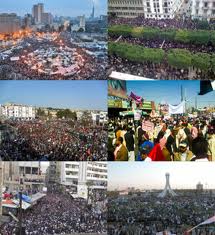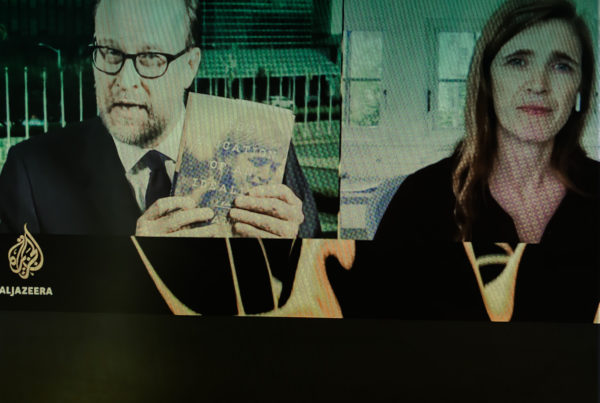 The six books reviewed here offer a range of perspectives on the political and social upheavals that began in Tunisia in December 2010 and have since engulfed other countries – events that became known as the Arab Spring. The phrase appears on the dust-jackets of nearly a hundred books published within the past year in English alone. Never mind that these events began in winter, in places where winter is a brief respite from an endless summer, and spring is more a concept than a time of year, or that “Arab” is an ethnic misnomer. Coincidentally, these six books, each with a different message and great quantities of information, barely mention the environment, the catastrophic land and water shortages, adversarial heat, pollution and poor health affecting millions in desert countries. Such is the Arab Spring: soundbite, oxymoron, spectacle, a screen on which to project abstracted hopes and fears.
The six books reviewed here offer a range of perspectives on the political and social upheavals that began in Tunisia in December 2010 and have since engulfed other countries – events that became known as the Arab Spring. The phrase appears on the dust-jackets of nearly a hundred books published within the past year in English alone. Never mind that these events began in winter, in places where winter is a brief respite from an endless summer, and spring is more a concept than a time of year, or that “Arab” is an ethnic misnomer. Coincidentally, these six books, each with a different message and great quantities of information, barely mention the environment, the catastrophic land and water shortages, adversarial heat, pollution and poor health affecting millions in desert countries. Such is the Arab Spring: soundbite, oxymoron, spectacle, a screen on which to project abstracted hopes and fears.
Marc Lynch
THE ARAB UPRISING
The unfinished revolutions of the new Middle East
273pp. Public Affairs Books. $26.99.978 1 61039 084 2John R. Bradley
AFTER THE ARAB SPRING
How Islamists hijacked the Middle East revolts
250pp. Palgrave Macmillan. £10.99.
978 0 230 33819 7Joshua Stacher
ADAPTABLE AUTOCRATS
Regime power in Egypt and Syria
256pp. Stanford University Press. Paperback, $24.95; distributed in the UK by Eurospan. £22.50.
978 0 8047 8063 6Hamid Dabashi
THE ARAB SPRING
The end of postcolonialism
262pp. Zed Books. Paperback, £12.99 (US $19.95).
978 1 78032 223 0Magdi Amin et al
AFTER THE SPRING
Economic transitions in the Arab world 192pp. Oxford University Press. £22.50 (US $35).
978 0 19 992492 9Nasser Weddady and Sohrab Ahmari, editors
ARAB SPRING DREAMS
The next generation speaks out for freedom and justice from North Africa to Iran
235pp. Palgrave Macmillan. Paperback, £11.99 (US $17).
978 0 230 11592 7
Marc Lynch’s The Arab Uprising: The unfinished revolutions of the new Middle East provides a cogent country-by-country summary of the turbulent months between December 2010 and early 2012, alongside their reverberations in the White House. Lynch, who edits the Middle East Channel for ForeignPolicy.com, started blogging about regional affairs in 2002, placing a welcome emphasis on pop culture and the effects of satellite television and the internet in countries with a largely youthful population formerly accustomed to strict censorship. He alone followed the media phenomenon since its beginnings and is alert to the generational divide within societies, as well as the military and religious establishments that will continue to inform these uprisings.
The Arab Spring marks the coming of age of the “new Arab public sphere” that Lynch identified a decade ago, and which has since “rewired the game of regional politics”. “Many will want to reduce this vibrant new public to easy stereotypes” he warns, “whether Islamist menace or liberal youth rejecting elders. Making such generalizations about an Arab public that spans dozens of countries is dangerous.” But that is what he repeatedly does in phrases like “an empowered Arab public” and statements such as “Arab publics see regional issues as intimately related to domestic ones”, or “Arabs were integrated within a shared political space, united by a common identity, a shared narrative”. Although remarking that most accounts of the uprisings neglect the fundamental role of workers’ movements and the plethora of social injustices that favoured a religious insurgence, Lynch adds little to our knowledge of these, and likewise overlooks the possibility that the common source from which these revolts sprang is a human not an Arab one.
But brisk summaries of complex events with deep historical roots and implications are useful, especially for busy people like the Washington policy-makers Marc Lynch consults with frequently. He defends President Obama, accused by some of “leading from behind” throughout the Arab Spring, affirming that one of his administration’s “best moves . . . was to recognize that the Arab upheavals did not depend on or want American leadership”. Furthermore, “by simply not being George W. Bush, \[Obama\] made America’s support for Arab aspirations conceivable”. During Bush’s administration, no Arab country began a transition to democracy, whereas under Obama, by the end of summer 2011, Egypt, Tunisia and Libya did – “not a bad record for an administration that supposedly did not care about Arab democracy”. But can the US take credit for making something “conceivable”, while sidestepping long-term support for a posse of tyrants? Apparently, in a world “under Obama”, yes, they can.
As Lynch dances uneasily around the United States’ obeisance to Israel and the “unavoidable hypocrisy” of not backing pro-democracy protests in Bahrain (because the US Navy’s Fifth Fleet is based there and neighbouring Saudi Arabia disapproved), we sense that he, like President Obama, is thinking about his future. When he explains that “Arabs are people . . . internally divided, sometimes confused, often brilliant”, we can only wonder who he feels needs reminding.
While Lynch is speaking platitudes to power, the foreign correspondent John R. Bradley, author of After the Arab Spring, has nothing but contempt for political posturing, and is out to debunk the myth of the Arab Spring as a triumph of the people. “When the gift of democracy is unwrapped”, he writes, “it is the Islamists who will spring out of the box.” Nor were these revolts driven by the urge for democracy, he argues convincingly: “the chief grievance of the Arab masses was not a lack of freedom but a lack of jobs”.
Consider Tunisia, a small, literate country where abortion is legal and sex education taught in a world-class education system, all thanks to Habib Bourguiba, who led the fight for independence from France and ruled “with an iron fist” for thirty years. The still-beloved Bourguiba held power by limiting political freedoms but granting social ones and raising middle-class living standards. Here was a “Muslim authoritarian country” that got it right. It might have continued, had Bourguiba’s successor, Zine El-Abidine Ben Ali, been less greedy and arrogant, his wife less ostentatious and her family less thuggish and opportunistic. Tunisians objected, but what did they get?
Bradley paints a sinister portrait of Rashid Ghannouchi, leader of the Islamist Ennahda party and head of Tunisia’s elected interim government. When Ghannouchi states “we want a system based on coalitions since only this will protect us from tyranny”, Bradley hears “a power sharing deal”, where liberals have some say in the economy while the Islamists “pursue [their] social agenda of Islamizing Tunisian society from below . . . [eradicating] the country’s secular inheritance [and] dragging Tunisia, chanting and ululating, back to the Middle Ages”. Far from empowering the people, the Jasmine Revolution was “the dumbest most selfdefeating uprising in history” and the Arab Spring a dismal failure that “socially and economically has put back countries like Tunisia, Yemen and Syria by decades”.
There is much to support Bradley’s assertion, not least Egypt’s recent election of an Islamist President and its economic straits. He has lived for many years in the region, and has been right before; Inside Egypt: The land of the pharaohs on the brink of a revolution (2008) was banned by the Mubarak regime whose demise it accurately foretold. This book suggests that wherever there are Muslims, however moderate, Islamism is waiting in the wings, and includes reports from other countries including in South East Asia. Bradley does not bother to distinguish between the Muslim faith and Islamism, the political ideology, until near the end of the book, but meanwhile explains that “Islamism . . . is like a drug addiction . . . \[leading\] only to a craving for more Islamic Islamism”: sounds a bit like capitalism. Bradley might have recalled that leaders of Islamist groups such as Egypt’s Muslim Brothers are businessmen, some less interested in parsing the Prophet’s utterances than consolidating their assets.
Those who share his views may enjoy Bradley’s vitriol, but it undermines his arguments. His closing rant against the hypocrisy of ideologues, politicians, warlords and liberals might have been a tour de force, were its tone less reminiscent of the paranoid ravings issuing from some mosques after Friday prayers. But Bradley is on to something about the way society governs itself, the powers it hands to certain men whose weaknesses render them unfit for it, the religious forces that step in to supply the missing higher values only to debase them. It is an old and apparently never-ending story, whose seemingly dramatic plot twists disguise a stealthy continuity.
“If we want things to stay as they are, things will have to change.” Joshua Stacher’s Adaptable Autocrats opens with this line from Lampedusa’s The Leopard and proceeds to illustrate its wisdom, showing how power seeks to preserve itself and therefore how the seemingly inflexible authoritarian regimes of Syria and Egypt bent with the winds of the Arab Spring without breaking. Egypt’s top-heavy, centralized power structure toppled more easily than Syria’s decentralized one (with multiple vying elites), but its response to the uprisings was more agile. Hosni Mubarak fell but the militaristic regime he had led regrouped under the auspices of the now near-autonomous Supreme Military Council. Egypt’s first democratic presidential elections were spectacles designed to offer the public the illusion of change, Stacher wrote recently in the New York Times, whereas back-room deals with the Muslim Brothers only cemented the generals’ position.
Stacher, assistant professor of political science at Kent State University, dissects decades of power manoeuvrings, including the Syrian regime’s success in passing the presidency from father to son, Egypt’s failed attempts to do so, and the development of Egypt’s brutal internal security apparatus since the 1990s to adapt to growing threats of social unrest such as domestic terrorism, political opposition, and the workers’ movement that helped fuel the uprising in 2011. Strikes are illegal in Egypt, yet 2,000 of them occurred between 2004 and 2008, and 700 in 2010 alone, some involving tens of thousands and lasting weeks, all demanding a living wage.
Although mentioning the concept of “dignity” as a motivation for the revolts, this scholarly work makes few concessions to social and cultural factors. Describing “neo-patriarchy” (“a process where the state blends its patrimonial inherited culture into its institutions”) was unavoidable in a discussion of autocracy, except there is nothing “neo” about it. The patriarchal format is older than God, a hierarchy born in families, extended to tribes, enshrined in religions, mirrored in businesses and bureaucracies and iterated in governments where an infantilized public has limited rights but is relieved of civic responsibilities. Stacher is convinced that “the lack of political development in individual Arab states stems from other institutional, historical, economic . . . geneses – not cultural or social causes”, as if they were somehow separate.
In contrast, Hamid Dabashi, Professor of Iranian Studies at Columbia University, sees the Arab Spring as society’s rejection of “business as usual”, and the beginning of a transnational civil rights movement. “The Arab revolutions are creating a new geography of liberation, which is no longer mapped on colonial or cast on post-colonial structures of domination . . . the ground is shifting under the feet of what selfproclaimed superpowers thought was their globe . . . these revolutions are collective acts of overcoming. This is no longer the middle of anyone’s east.” The Arab Spring: The end of postcolonialism was written in the heat of the moment, as Tunisians and Egyptians protested in their great concordant numbers while much of the world cheered, including the Iran-born Dabashi, who also identified Tehran’s so-called Green Revolution in 2009 as a civil rights struggle. “The Arab Spring signifies . . . a retrieval of a cosmopolitan worldliness that was always there but repressed”, Professor Dabashi writes. It is “the end not only of militant Islamism but of all absolutist ideologies and the false divisions and choices they have imposed”. Islamism is “exhausted”, Dabashi declares; all evidence to the contrary is presumably its death rattle.
Dabashi is not denying reality, only suggesting another way of looking at it. “How we read the events unfolding in ‘the Arab and the Muslim world’ is precisely contingent on how able we are . . . to place these events within that unraveling concept.” The revolts are “remapping the imaginative geography of a liberation that has finally moved beyond . . . ethnos, and that reaches deep and far into the configuration of a new planetary ethos . . . the world is finally discovered to be a planet, not a metaphysical bi-polarity along an east–west axis”.
Hamid Dabashi was not alone in seeing the Arab Spring as a portal to a world united in its rejection of greed, war and environmental devastation. His views in this regard are impassioned and inspiring; if only they weren’t buried in academic jargon and discursive harangues. For someone announcing the end of postcolonialism, Dabashi is far from finished with it. He wants a global ethos, but not until he has crucified the old ethnos and all the anthropologists, ethnographers, ethnographic museums and “west and the rest” agendas that go with it. At the top of a long list is “the imaginative heart of ‘the Empire’, National Geographic Magazine”. “The Arab Spring . . . is the end of National Geographic Magazine”, Professor Dabashi intones.
The more pragmatic After the Spring, the product of a Brookings Institution workshop, usefully outlines what is needed to rebuild a modern state. With “the bulk of the world’s attention . . . focused on the usual mix of global security, regional politics and Middle East peace implications”, the authors assess the socio-economic climate as a causal factor of the revolts and the storm still brewing in their wake. Nearly two-thirds of the so-called Arab World is under the age of thirty, youth unemployment rates are among the world’s highest, female presence in the workforce, the world’s lowest. This slim volume of sound research and analysis describes the political and public commitment required to institute participatory processes in countries long controlled by small elites, starting with a new social contract to replace the one where limited political freedoms were compensated for with subsidized necessities including food, fuel and education. The authors address questions such as how to restore public trust in governments and regain support from an international financial community with problems of its own. Pooling regional resources would help. For now, these countries have some of the world’s lowest intra-regional trade rates; so much for pan-Arabism. If cooperation within and between nations is the way forward, this book suggests the immensity of the task.
Arab Spring Dreams was written by those with the most at stake, people under the age of twenty-six living in places where conformism and obedience pass for cooperation. Nasser Weddady and Sohrab Ahmari perceptively edited this collection of winning entries from an essay contest with the theme “a dream deferred”, begun in 2005 by a Syrian dissident, Ammar Abdulhamid, founder of the American Islamic Congress, a civil rights organization. The authors describe the gratuitous daily obstacles and humiliations that state and religious institutions lay like traps to break spirits and discourage initiative. A couple in a park holding hands is interrogated by police, women are forbidden to drive cars, students questioning scripture are awarded a lower grade. Some of these young writers possess more clarity than all the pundits combined. “Our world is falling apart because our will is weak”, writes a twenty-five-year-old Egyptian; “we lack the will to share in each other’s humanity.”
Maria Golia is the author of Cairo: City of sand, 2004, and Photography in Egypt, 2010. She lives in downtown Cairo.
Marc Lynch
THE ARAB UPRISING
The unfinished revolutions of the new Middle East
273pp. Public Affairs Books. $26.99.978 1 61039 084 2
John R. Bradley
AFTER THE ARAB SPRING
How Islamists hijacked the Middle East revolts
250pp. Palgrave Macmillan. £10.99.
978 0 230 33819 7
Joshua Stacher
ADAPTABLE AUTOCRATS
Regime power in Egypt and Syria
256pp. Stanford University Press. Paperback, $24.95; distributed in the UK by Eurospan. £22.50.
978 0 8047 8063 6
Hamid Dabashi
THE ARAB SPRING
The end of postcolonialism
262pp. Zed Books. Paperback, £12.99 (US $19.95).
978 1 78032 223 0
Magdi Amin et al
AFTER THE SPRING
Economic transitions in the Arab world 192pp. Oxford University Press. £22.50 (US $35).
978 0 19 992492 9
Nasser Weddady and Sohrab Ahmari, editors
ARAB SPRING DREAMS
The next generation speaks out for freedom and justice from North Africa to Iran
235pp. Palgrave Macmillan. Paperback, £11.99 (US $17).
978 0 230 11592 7



